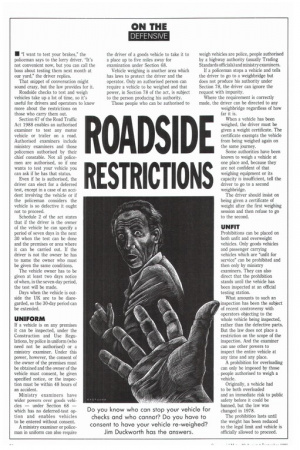OADSIDE
Page 36

If you've noticed an error in this article please click here to report it so we can fix it.
ESTRICTIONS
• "I want to test your brakes," the policeman says to the lorry driver. "It's not convenient now, but you can call the boss about testing them next month at our yard," the driver replies.
That snippet of conversation might sound crazy, but the law provides for it.
Roadside checks to test and weigh vehicles take up a lot of time, so it's useful for drivers and operators to know more about the restrictions on those who carry them out.
Section 67 of the Road Traffic Act 1988 enables an authorised examiner to test any motor vehicle or trailer on a road. Authorised examiners include ministry examiners and those policemen authorised by their chief constable. Not all policemen are authorised, so if one wants to test your vehicle you can ask if he has that status.
Even if he is authorised, the driver can elect for a deferred test, except in a case of an accident involving the vehicle or if the policeman considers the vehicle is so defective it ought not to proceed.
Schedule 2 of the act states that if the driver is the owner of the vehicle he can specify a period of seven days in the next 30 when the test can be done and the premises or area where it can be carried out. If the driver is not the owner he has to name the owner who must be given the same conditions.
The vehicle owner has to be given at least two days notice of when, in the seven-day period, the test will be made.
Days when the vehicle is outside the UK are to be disregarded, so the 30-day period can be extended.
UNIFORM
If a vehicle is on any premises it can be inspected, under the Construction and Use Regulations, by police in uniform (who need not be authorised) or a ministry examiner. Under this power, however, the consent of the owner of the premises must be obtained and the owner of the vehicle must consent, be given specified notice, or the inspection must be within 48 hours of an accident, Ministry examiners have wider powers over goods vehicles — under Section 68 — which has no deferred-test option and enables vehicles to be entered without consent.
A ministry examiner or policeman in uniform can also require the driver of a goods vehicle to take it to a place up to five miles away for examination under Section 68.
Vehicle weighing is another area which has laws to protect the driver and the operator. Only an authorised person can require a vehicle to be weighed and that power, in Section 78 of the act, is subject to the person producing his authority.
Those people who can be authorised to weigh vehicles are police, people authorised by a highway authority (usually Trading Standards officials) and ministry examiners.
If a policeman stops a vehicle and tells the driver to go to a weighbridge but does not produce his authority under Section 78, the driver can ignore the request with impunity.
Where the requirement is correctly made, the driver can be directed to any weighbridge regardless of how far it is.
When a vehicle has been weighed, the driver must be given a weight certificate. The certificate exempts the vehicle from being weighed again on the same journey.
Some authorities have been known to weigh a vehicle at one place and, because they are not confident of that weighing equipment or its capacity is insufficient, tell the driver to go to a second weighbridge.
The driver should insist on being given a certificate of weight after the first weighing session and then refuse to go to the second.
UNFIT
Prohibitions can be placed on both unfit and overweight vehicles. Only goods vehicles and passenger carrying vehicles which are "unfit for service" can be prohibited and then only by ministry examiners. They can also direct that the prohibition stands until the vehicle has been inspected at an official testing station.
What amounts to such an inspection has been the subject of recent controversy with operators objecting to the whole vehicle being inspected, rather than the defective parts. But the law does not place a restriction on the scope of the inspection. And the examiner can use other powers to inspect the entire vehicle at any time and any place.
A prohibition for overloading can only be imposed by those people authorised to weigh a vehicle.
Originally, a vehicle had to be both overloaded and an immediate risk to public safety before it could be banned, but the law was changed in 1978.
The prohibition lasts until the weight has been reduced to the legal limit and vehicle is officially allowed to proceed_
















































































